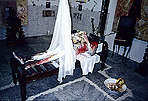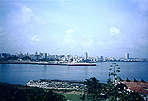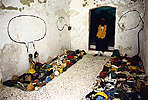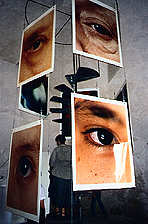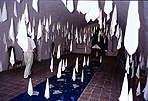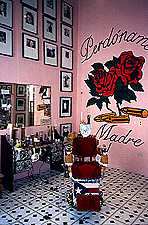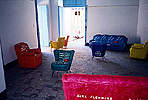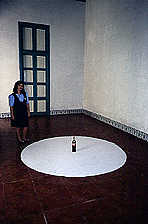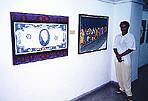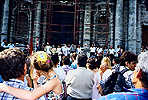
|
|
Art Watch Index - Jun. 17, 1997
![]()
6th Biennial of Havana
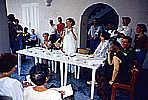
Director Llilian Llanes of the Wifredo Lam Center, making a passionate speech at the press conference of the Biennial. At the Lam Center.
Tokihiro SATO in front of his exhibited work. At La Casona in Old Havana.
The bizarre work is an installation by the Jamaican artist, David Boxer. It is said that he even uses a sample of the human brain. At Old Havana.
Havana seen from Castillo del Morro across the canal.
The work by Romuald Hazoume, an artist from Benin, Africa, using colorful plastic waste. At Castillo del Morro.
The gigantic photograph of an eye wrapped around the spiral staircase is an installation by the Peruvian artist, Roberto Huarcaya. At Castillo del Morro.
The Fortaleza de la Cabana. Exhibitions are done in the rooms in the buildings on both sides of the road.
A work by Priscilla Monge, an artist from Costa Rica, where a small music box is attached to a headgear. At Fortaleza de la Cabana.
The cool-looking installation with many hung handkerchiefs, is by Flavio Pons from Brazil. At Fortaleza de la Cabana.
The letters, "mother, forgive me", and the "barber shop" with roses and a picture of a bullet, create the installation by Pepon Osorio from Puerto Rico. At Old Havana.
The brilliantly colored sofa is an installation by Alex Flemming from Brazil. The words written on the sofa are a message relating to a current event, "Tupac Amaru attacks the Japanese Embassy in Peru demanding the release of their members". At Old Havana.
Arahmaiani, an artist from Indonesia put ashes in a circle on the floor, and placed a Coca-Cola bottle covered with a condome in the middle. The artist recently did a similar work at the Tokyo Metropolitan Contemporary Art Museum. The theme is said to be the "Invasion of American Consumer Civilization". At the Casa de Asia in Old Havana.
Jacqueline Brito Jorge and her work. She is a young artist who opened a solo exhibition at the Museo de la Revolucion in Havana, with the support from the Ludwig Foundation which supports Cuban contemporary artists. At the opening ceremony at this museum.
The gallery of the University of Havana. Juan Grillo, a Cuban painter, and his work at the Galeria L. At the same gallery in the Vedado district in Havana. Photography: Satoru NAGOYA
6th Biennial of Havana. Universe in Universe http://www.kulturbox.de/ univers/car/havanna/ english.htm
6th Biennial of Havana: Venues. Universe in Universe
Wifredo Lam Center
Lam Center
Wifredo Lam - Reference Page
Fidel Intro Page
|
[Art Watch Special]
May 1, 1997 (Thursday)
May 2 (Friday) The Lam Center, established inside an architecture apparently derived from the colonial period, was alive with the art crowd. There were visitors from Japan, including the only participating Japanese artist, Tokihiro SATO, Motoi MASAKI, a curator from the Meguro Museum of Art known as a great "Cuba fan", and Kohtaro IIZAWA, a photography critic. At the press conference, the director of this center and the director of the Biennial, Llilian Llanes, passionately spoke about how difficult the realization of this Biennial was, overcoming financial problems. I asked her, "What was the budget of the Biennial?", but her answer was, "It is made possible from donations from many different areas. I do not know about the budget." After the press conference, I looked around the exhibition together with Sato and Masaki. The theme of this Biennial, consisting of 177 artists from 44 countries, is "The Individual and His Memory". The Biennial site was divided into 3 areas; in the area around Old Havana near the Lam Center, the exhibition title was "Collective Memories", at the Castillo del Morro standing opposite Old Havana across the canal, it was "Faces of Memory", and at the Fortaleza de la Cabana next to the Castillo del Morro, it was "Internal Domains", and each exhibition was done separately. However, the works exhibited did not necessarily follow the themes. Located immediately on the south of the tropic of Cancer and facing the ocean, in Havana, the strong sun and the salty sea breeze make the air hot and humid, and sweat pours out just standing still. SATO's work produced locally was displayed in the gallery surrounding a patio, located on the second floor of a large mansion built in the 18th century, called "La Casona". His work was titled "Photo-Respiration", and was a series consisting of 12 pieces of 180x220cm gelatin silver transparencies. They were hung facing the bright patio. In these photographs, scenes of such landmarks of Havana such as the square in Old Havana, the cathedral and a missile remaining on a hilltop, were adorned with the remnant of light created by Sato as he walked around these scenes reflecting sunlight from a hand mirror, exposing the film for a long time. In the afternoon, we chartered an unlicensed taxi - a Chevrolet which seemed to be from the '50's - for four hours at 20 dollars, and I visited Castillo del Morro and Fortaleza de la Cabana. There were still many works in progress. A little after four in the afternoon, hearing that President Akira ISHINO of Press Kit Co., the corporation which supported the Biennial from Japan, and related guests were to pay a visit to Director Llanes of the Lam Center, I accompanied the group. According to the director, Fidel Castro, Cuba's supreme leader, has never visited this Biennial.
May 3 (Saturday)
May 4 (Sunday) The first Biennial of Havana was held in 1984. Originally, the event centered on Central and Southern American countries, but later, they expanded the range to Africa and Asia, becoming the "third art festival of the world", worthy of honoring Wifredo Lam, born of a Latin American, African, and Asian lineage. Different from the other biennials, they do not have a system where commissioners from each country choose the participating artists. Here, the eight curators of the Lam Center directly select the artists. As a result, in this biennial, there were over 2 0 artists each from Brazil and Argentina, which was the highest record. There were very few participants from the United States or Europe. From Japan, Sato was the first artist to participate. Looking at the past themes of the biennial, it is typical of Cuba to have themes like "migration", and "a battle against the new colonialism". The theme of "memory" for this event was said to indicate the "virtue of human beings" which should be remembered at the turn of the century, according to Director Llanes, but when we speak of "memory" in the Latin American countries, the outstanding characteristic is the tragic memory of the colonialistic periods and the military rule which continued until the end of the '80's in some countries. Maybe due to this fact, dark works which made us imagine violence or death also stood out. Ninety-five percent of the exhibition consisted of installations, which is the most suitable form for such a content. Surrounded by many works which were not familiar to us unless we knew the history and social background of Latin America, Sato's work was impressive for its clarity and beauty which could be understood by anyone who visited Havana.
May 5 (Monday)
May 6 (Tuesday) Four o'clock in the afternoon. At the Museo de la Revolucion in the city, that introduces the history leading to the Cuban Revolution in 1959, starting from the anti-government conflict that kicked off from Santiago de Cuba in the eastern part of Cuba in 1953, there was the opening of the solo exhibition of Jacqueline Brito Jorge, who is supported by the Cuba office of the Ludwig Foundation, a cultural support organization headquartered in Aachen, Germany. Jorge is a young female artist in her early 20's, and this time, she exhibited a painting incorporating mosaic. This foundation in Cuba states that their objective is to "support Cuban contemporary art both domestically and in the overseas" (Representative Helmo Hernandez). Cuba Libre (rum and cola) was served. This is a cocktail representing Cuba together with "Mojito", which is rum flavored with mint.
May 7 (Wednesday)
May 8 (Thursday)
May 9 (Friday) [Satoru NAGOYA/Art Journalist]
|
||||
|
|
|
||||
|
|
|
|
|
[home]/[Art Information]/[Column]
Copyright (c) Dai Nippon Printing Co., Ltd. 1997
Network Museum & Magazine Project / nmp@nt.cio.dnp.co.jp

